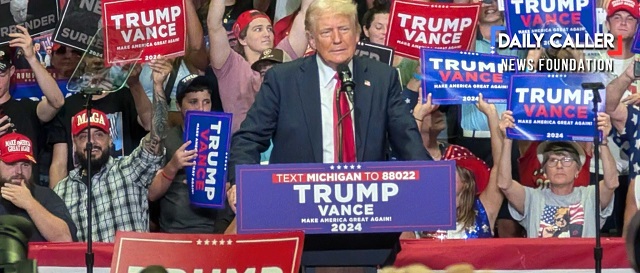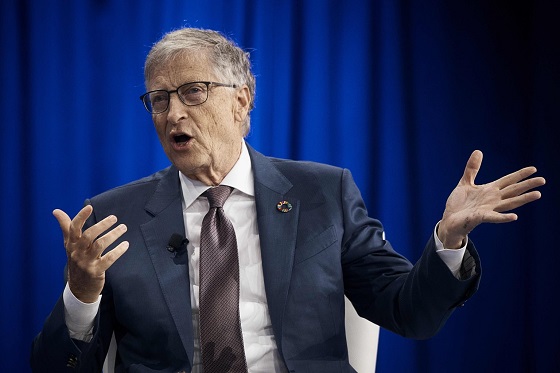Economy
Trump’s Promise Of American Abundance, Fueled By ‘Liquid Gold’

 From the Daily Caller News Foundation
From the Daily Caller News Foundation
One of the brightest nuggets of policy in Donald Trump’s July 18 acceptance speech to the Republican convention in Milwaukee was his ode to “liquid gold.” That is, oil.
As part of his inflation-fighting plan, Trump offered a gleaming solution: increase energy production, thereby decreasing energy prices. “By slashing energy costs,” Trump declared, “we will in turn reduce the cost of transportation, manufacturing and all household goods.”
He continued: “We have more liquid gold under our feet than any other country by far. We are a nation that has the opportunity to make an absolute fortune with its energy.”
Indeed. According to the Institute for Energy Research (IER) technically recoverable oil resources in the U.S. total 2.136 trillion barrels. At the current price of around $80 a barrel, that’s some $171 trillion. And so, Trump concluded, “we will reduce our debt, $36 trillion.”
As former Alaska governor Sarah Palin would say, “You betcha.” In Palin’s Alaska, oil is so abundant, relative to the population, that everyone gets a check from the state. Last year, it was $1,312. For a family of four, that’s more than $5000. Our goal should be that every American gets such an energy dividend.
Moreover, the abundance of America’s carbon fuels is not limited to oil. According to IER, we have 3.391 trillion cubic feet of natural gas. That’s worth $165 trillion.
To be sure, these staggering dollar totals can’t be counted directly against the national debt—or in support of some future tax cut. Yet every dollar of our energy assets would contribute to the economy, and if even 10 percent of the humongous total could be available to the public, we could, in fact, pay off the national debt.
Moreover, thanks to fracking and other enhanced recovery techniques, we keep finding more energy: Human ingenuity has upended old beliefs about energy shortages, ushering in an almost Moore’s Law-ish surge in production.
Indeed, there’s so much oil and gas (and coal) that an emerging school of thought holds that carbon fuels aren’t “fossil” at all, but rather, the product of earth’s vulcanism. The core of this earth, after all, is the same temperature as the surface of the sun. Perhaps all that heat is cooking something.
In any case, we keep finding more oil, and not just in the U.S.
So how, exactly, do we take advantage of this planetary cornucopia? As Palin said, as Trump said, and as the convention crowd chanted, “drill, baby, drill.”
Okay, but what about climate change? Most Republicans don’t worry too much about that, but if Democrats do, they should be reassured that we can capture the carbon and so take it out of the atmosphere. Trees and other green vegetation have been capturing carbon for eons; the element is, in fact, vital to their very existence. Similarly, the human body is 18 percent carbon. Yes, all of us ourselves are carbon sinks.
So we, being smart, can capture vastly more carbon — capturing it in everything from wood to cement, from plastics to nanotubes. These in turn can be landfill, construction materials — maybe even a space elevator.
We can, in fact, establish a a circular carbon economy: carbon fuels extracted, burned, and then recycled back into feedstocks. By this reckoning, carbon fuels are renewable. Such creative thinking can power all those energy-hungry data centers on which Big Tech and AI depend. So there’s the makings of a bipartisan “Grand Carbon Bargain,” uniting mostly blue-state tech with mostly red-state energy. More energy + more tech = more wealth for all.
In Milwaukee, Trump spoke of American “energy dominance,” and that’s great. But with all the energy we can produce and consume, we can speak of economic abundance — and that’s even greater.
James P. Pinkerton served in the White House domestic policy offices of Presidents Ronald Reagan and George H.W. Bush. He is the author, most recently, of “The Secret of Directional Investing: Making Money Amidst the Red-Blue Rumble.”
Business
Fuelled by federalism—America’s economically freest states come out on top

From the Fraser Institute
Do economic rivalries between Texas and California or New York and Florida feel like yet another sign that America has become hopelessly divided? There’s a bright side to their disagreements, and a new ranking of economic freedom across the states helps explain why.
As a popular bumper sticker among economists proclaims: “I heart federalism (for the natural experiments).” In a federal system, states have wide latitude to set priorities and to choose their own strategies to achieve them. It’s messy, but informative.
New York and California, along with other states like New Mexico, have long pursued a government-centric approach to economic policy. They tax a lot. They spend a lot. Their governments employ a large fraction of the workforce and set a high minimum wage.
They aren’t socialist by any means; most property is still in private hands. Consumers, workers and businesses still make most of their own decisions. But these states control more resources than other states do through taxes and regulation, so their governments play a larger role in economic life.
At the other end of the spectrum, New Hampshire, Tennessee, Florida and South Dakota allow citizens to make more of their own economic choices, keep more of their own money, and set more of their own terms of trade and work.
They aren’t free-market utopias; they impose plenty of regulatory burdens. But they are economically freer than other states.
These two groups have, in other words, been experimenting with different approaches to economic policy. Does one approach lead to higher incomes or faster growth? Greater economic equality or more upward mobility? What about other aspects of a good society like tolerance, generosity, or life satisfaction?
For two decades now, we’ve had a handy tool to assess these questions: The Fraser Institute’s annual “Economic Freedom of North America” index uses 10 variables in three broad areas—government spending, taxation, and labor regulation—to assess the degree of economic freedom in each of the 50 states and the territory of Puerto Rico, as well as in Canadian provinces and Mexican states.
It’s an objective measurement that allows economists to take stock of federalism’s natural experiments. Independent scholars have done just that, having now conducted over 250 studies using the index. With careful statistical analyses that control for the important differences among states—possibly confounding factors such as geography, climate, and historical development—the vast majority of these studies associate greater economic freedom with greater prosperity.
In fact, freedom’s payoffs are astounding.
States with high and increasing levels of economic freedom tend to see higher incomes, more entrepreneurial activity and more net in-migration. Their people tend to experience greater income mobility, and more income growth at both the top and bottom of the income distribution. They have less poverty, less homelessness and lower levels of food insecurity. People there even seem to be more philanthropic, more tolerant and more satisfied with their lives.
New Hampshire, Tennessee, and South Dakota topped the latest edition of the report while Puerto Rico, New Mexico, and New York rounded out the bottom. New Mexico displaced New York as the least economically free state in the union for the first time in 20 years, but it had always been near the bottom.
The bigger stories are the major movers. The last 10 years’ worth of available data show South Carolina, Ohio, Wisconsin, Idaho, Iowa and Utah moving up at least 10 places. Arizona, Virginia, Nebraska, and Maryland have all slid down 10 spots.
Over that same decade, those states that were among the freest 25 per cent on average saw their populations grow nearly 18 times faster than those in the bottom 25 per cent. Statewide personal income grew nine times as fast.
Economic freedom isn’t a panacea. Nor is it the only thing that matters. Geography, culture, and even luck can influence a state’s prosperity. But while policymakers can’t move mountains or rewrite cultures, they can look at the data, heed the lessons of our federalist experiment, and permit their citizens more economic freedom.
Business
The world is no longer buying a transition to “something else” without defining what that is

From Resource Works
Even Bill Gates has shifted his stance, acknowledging that renewables alone can’t sustain a modern energy system — a reality still driving decisions in Canada.
You know the world has shifted when the New York Times, long a pulpit for hydrocarbon shame, starts publishing passages like this:
“Changes in policy matter, but the shift is also guided by the practical lessons that companies, governments and societies have learned about the difficulties in shifting from a world that runs on fossil fuels to something else.”
For years, the Times and much of the English-language press clung to a comfortable catechism: 100 per cent renewables were just around the corner, the end of hydrocarbons was preordained, and anyone who pointed to physics or economics was treated as some combination of backward, compromised or dangerous. But now the evidence has grown too big to ignore.
Across Europe, the retreat to energy realism is unmistakable. TotalEnergies is spending €5.1 billion on gas-fired plants in Britain, Italy, France, Ireland and the Netherlands because wind and solar can’t meet demand on their own. Shell is walking away from marquee offshore wind projects because the economics do not work. Italy and Greece are fast-tracking new gas development after years of prohibitions. Europe is rediscovering what modern economies require: firm, dispatchable power and secure domestic supply.
Meanwhile, Canada continues to tell itself a different story — and British Columbia most of all.
A new Fraser Institute study from Jock Finlayson and Karen Graham uses Statistics Canada’s own environmental goods and services and clean-tech accounts to quantify what Canada’s “clean economy” actually is, not what political speeches claim it could be.
The numbers are clear:
- The clean economy is 3.0–3.6 per cent of GDP.
- It accounts for about 2 per cent of employment.
- It has grown, but not faster than the economy overall.
- And its two largest components are hydroelectricity and waste management — mature legacy sectors, not shiny new clean-tech champions.
Despite $158 billion in federal “green” spending since 2014, Canada’s clean economy has not become the unstoppable engine of prosperity that policymakers have promised. Finlayson and Graham’s analysis casts serious doubt on the explosive-growth scenarios embraced by many politicians and commentators.
What’s striking is how mainstream this realism has become. Even Bill Gates, whose philanthropic footprint helped popularize much of the early clean-tech optimism, now says bluntly that the world had “no chance” of hitting its climate targets on the backs of renewables alone. His message is simple: the system is too big, the physics too hard, and the intermittency problem too unforgiving. Wind and solar will grow, but without firm power — nuclear, natural gas with carbon management, next-generation grid technologies — the transition collapses under its own weight. When the world’s most influential climate philanthropist says the story we’ve been sold isn’t technically possible, it should give policymakers pause.
And this is where the British Columbia story becomes astonishing.
It would be one thing if the result was dramatic reductions in emissions. The provincial government remains locked into the CleanBC architecture despite a record of consistently missed targets.
Since the staunchest defenders of CleanBC are not much bothered by the lack of meaningful GHG reductions, a reasonable person is left wondering whether there is some other motivation. Meanwhile, Victoria’s own numbers a couple of years ago projected an annual GDP hit of courtesy CleanBC of roughly $11 billion.
But here is the part that would make any objective analyst blink: when I recently flagged my interest in presenting my research to the CleanBC review panel, I discovered that the “reviewers” were, in fact, two of the key architects of the very program being reviewed. They were effectively asked to judge their own work.
You can imagine what they told us.
What I saw in that room was not an evidence-driven assessment of performance. It was a high-handed, fact-light defence of an ideological commitment. When we presented data showing that doctrinaire renewables-only thinking was failing both the economy and the environment, the reception was dismissive and incurious. It was the opposite of what a serious policy review looks like.
Meanwhile our hydro-based electricity system is facing historic challenges: long term droughts, soaring demand, unanswered questions about how growth will be powered especially in the crucial Northwest BC region, and continuing insistence that providers of reliable and relatively clean natural gas are to be frustrated at every turn.
Elsewhere, the price of change increasingly includes being able to explain how you were going to accomplish the things that you promise.
And yes — in some places it will take time for the tide of energy unreality to recede. But that doesn’t mean we shouldn’t be improving our systems, reducing emissions, and investing in technologies that genuinely work. It simply means we must stop pretending politics can overrule physics.
Europe has learned this lesson the hard way. Global energy companies are reorganizing around a 50-50 world of firm natural gas and renewables — the model many experts have been signalling for years. Even the New York Times now describes this shift with a note of astonishment.
British Columbia, meanwhile, remains committed to its own storyline even as the ground shifts beneath it. This isn’t about who wins the argument — it’s about government staying locked on its most basic duty: safeguarding the incomes and stability of the families who depend on a functioning energy system.
Resource Works News
-

 Crime23 hours ago
Crime23 hours agoTerror in Australia: 12 killed after gunmen open fire on Hanukkah celebration
-

 Crime22 hours ago
Crime22 hours agoHero bystander disarms shooter in Australian terror attack
-

 Business1 day ago
Business1 day agoInflation Reduction Act, Green New Deal Causing America’s Energy Crisis
-

 Business2 days ago
Business2 days agoFuelled by federalism—America’s economically freest states come out on top
-

 Daily Caller2 days ago
Daily Caller2 days ago‘There Will Be Very Serious Retaliation’: Two American Servicemen, Interpreter Killed In Syrian Attack
-

 illegal immigration2 days ago
illegal immigration2 days agoUS Notes 2.5 million illegals out and counting
-

 Automotive2 days ago
Automotive2 days agoPoliticians should be honest about environmental pros and cons of electric vehicles
-

 International2 days ago
International2 days agoTyler Robinson shows no remorse in first court appearance for Kirk assassination



